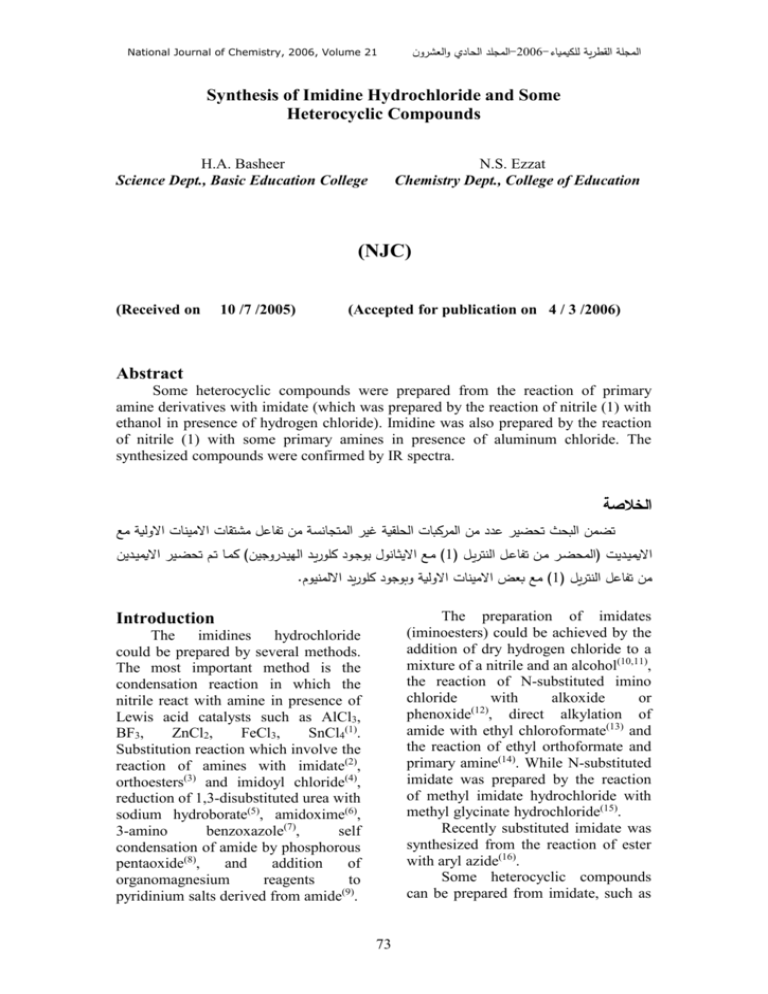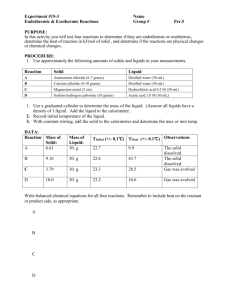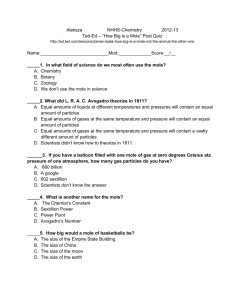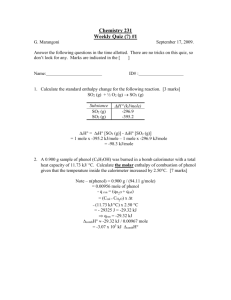Synthesis of Imidine Hydrochloride and Some
advertisement

المجلد الحادي والعشرون-2006-المجلة القطرية للكيمياء National Journal of Chemistry, 2006, Volume 21 Synthesis of Imidine Hydrochloride and Some Heterocyclic Compounds H.A. Basheer Science Dept., Basic Education College N.S. Ezzat Chemistry Dept., College of Education (NJC) (Received on 10 /7 /2005) (Accepted for publication on 4 / 3 /2006) Abstract Some heterocyclic compounds were prepared from the reaction of primary amine derivatives with imidate (which was prepared by the reaction of nitrile (1) with ethanol in presence of hydrogen chloride). Imidine was also prepared by the reaction of nitrile (1) with some primary amines in presence of aluminum chloride. The synthesized compounds were confirmed by IR spectra. الخالصة تضمن البحث تحضير عدد من المركبات الحلقية غير المتجانسة من تفاعل مشتقات االمينات االولية مع ) مدع االياددانوو ووجدود كلوريدد الجيددروجين) كمدا تدا تحضدير االيميدددين1( االيميدديت (المحضدر مدن تفاعدل النتريدل .) مع بعض االمينات االولية وبوجود كلوريد االلمنيوا1( من تفاعل النتريل The preparation of imidates (iminoesters) could be achieved by the addition of dry hydrogen chloride to a mixture of a nitrile and an alcohol(10,11), the reaction of N-substituted imino chloride with alkoxide or (12) phenoxide , direct alkylation of amide with ethyl chloroformate(13) and the reaction of ethyl orthoformate and primary amine(14). While N-substituted imidate was prepared by the reaction of methyl imidate hydrochloride with methyl glycinate hydrochloride(15). Recently substituted imidate was synthesized from the reaction of ester with aryl azide(16). Some heterocyclic compounds can be prepared from imidate, such as Introduction The imidines hydrochloride could be prepared by several methods. The most important method is the condensation reaction in which the nitrile react with amine in presence of Lewis acid catalysts such as AlCl3, BF3, ZnCl2, FeCl3, SnCl4(1). Substitution reaction which involve the reaction of amines with imidate(2), orthoesters(3) and imidoyl chloride(4), reduction of 1,3-disubstituted urea with sodium hydroborate(5), amidoxime(6), 3-amino benzoxazole(7), self condensation of amide by phosphorous pentaoxide(8), and addition of organomagnesium reagents to pyridinium salts derived from amide(9). 73 National Journal of Chemistry, 2006, Volume 21 imidazole(17), imidazoline(18), oxazole(15), benzimidazole(19), benzoxazole, benzothiazole(20), (21) (22) oxazoline , indole , purine(23) and pyrimidine(14). In this study preparation of new substituted imidines, imidates and some other heterocyclic compounds were achieved. المجلد الحادي والعشرون-2006-المجلة القطرية للكيمياء Synthesis of 2-[4-tolyl mercaptoethyl] thiazoline-4-one (4): Compound (3b) (1 gm) was refluxed in 20 ml of toluene for five hrs. Cooled the solution and evaporated the solvent to give the product and recrystallized from ethanol. The IR spectral data and the melting point were listed in Table (2). Synthesis of ethyl -(p-tolyl mercapto) propioimidate hydrochloride (5): A mixture of (0.1 mole) of (comp. 1) dissolved in (40 ml) of dry chloroform and (0.1 mole) of absolute ethanol is cooled to 0 C and saturated with dry hydrogen chloride gas. The flask is stoppered and place in refrigerator for 7 days and then equal volume of dry ether is added. The imidate hydrochloride precipitate and filtered. The melting point and IR spectral data is listed in Table (2). Synthesis of 2-[2-p-tolyl mercaptoethyl)] imidazoline (6a): A mixture of (0.01 mole) of comp. 5 and (0.01 mole) of redistillated ethylene diamine in 15 ml of absolute ethanol. The mixture is refluxed for 6 hrs and then kept at 0 C overnight. A small amount of salt was filtered. The filtrate evaporate and the residual recrystallized from water to produce a prism needles. The IR data and the physical constant were showed in Table (2). Synthesis of 2-[2-tolyl mercaptoethyl] oxazoline (6b): A mixture of (1.3 gm, 0.005 mole) comp. 5 and (0.61 gm, 0.01 mole) of ethanolamine in 20 ml of absolute ethanol was refluxed for 4 hrs., filtered the salt and evaporated the solvent to produce the product. Recrystallized from water. The IR spectral data and the melting point were showed in Table (2). Experimental Uncorrected melting point were determined using Electrothermal 9300 melting point apparatus. I.R. spectra was recorded by Infrared Spectrophotometer Model Tensor 27 Bruker Co. using KBr discs. -(p-tolyl mercapto) propionitrile (comp. 1) was prepared according to the published procedure(24). Synthesis of N-substituted -(p-tolyl mercapto) propioamidine hydrpchloride (comp. 2a-e): To a mixture of (0.02 mole) of comp. 1 and (0.02 mole) of amine was added slowly with stirring (0.02 mole) of anhydrous powdered aluminum chloride. The mixture is kept at 160 C for 20 min and while still molten is poured slowly into a solution of 1 ml of concentration of hydrochloric acid in (100 ml) of water. Collected the solid and recrystallized from suitable solvent. The IR spectral data and melting point were showed in Table (1). Synthesis of -imino[-(ptolylmercapto) ethyl] oxo or mercapto acetic acid hydrochloride (3a-b): A mixture of (0.01 mole) of comp. 1 dissolved in (10 ml) of dry chloroform and (0.01 mole) of glycolic or thioglycolic acid dissolved in dry chloroform, was cooled to 0 C and saturated with dry hydrogen chloride gas. The mixture is kept at 0 C for 24 hrs and added 30 ml of dry ether. The solid is filtrated and recrystallized from ethanol. The melting point and IR spectral data are indicated in Table (2). 74 National Journal of Chemistry, 2006, Volume 21 Synthesis of ethyl N-carboethoxy methyl -(p-tolyl mercapto) propioimidate (7)(25): At first prepare the free imidate by shaken the (0.01 mole) imidate hydrochloride in ether with a strong solution of potassium carbonate at 0 C. The ethereal solution was shaken with (0.01 mole) glycine ethyl ester hydrochloride in 2 ml of water for 1 hr. The ether layer was separated, washed with water, dried over sodium sulphate and the solvent evaporated to afford the crude product. The product was recrystallized from ethanol. The melting point and IR spectral data were showed in Table (2). Synthesis of 4-carboethoxy methylene-2-[2-tolyl mercaptoethyl] oxazoline (comp. 8)(26): A mixture of (0.01 mole) of comp. 5 in 20 ml of ether was shaken with 10 ml of 50% sodium hydroxide, the ether layer was separated and mixed with (0.01 mole) of ethyl serine ester hydrochloride in 3 ml of water. The two layers vigorously shaken together for 8 hrs. After that a sufficient water is added to dissolve the ammonium chloride. The ether layer separated, washed three times with water, dried and evaporated to give the product. The melting point and IR spectral data were showed in Table(2). Synthesis of 2-[2-tolyl mercapto ethyl] benzimidazole (9a)(1): To a suspension of (0.005 mole) of comp. 5 in 10 ml of methanol was added with stirring, a solution of (0.005 mole) of o-phenylene diamine in 10 ml methanol. After stirring for 30 min at 20-25 C a thick mass of crystals separates. The mixture was refluxed for 1 hr. Cooled and the precipitate filtered and washed with water to give the product. The melting point and IR spectral data were showed in Table (2). المجلد الحادي والعشرون-2006-المجلة القطرية للكيمياء Synthesis of 2-[2-tolyl mercaptoethyl] benzoxazole (9b)(1): A mixture of (0.005 mole) of comp. 5 and (0.005 mole) of o-aminophenol in 10 ml of dry methanol were heated on a steam bath for 30 min. After that cooled, water containing a little sodium carbonate was added to neutralize the solution. Evaporating the solvent afford the product. The melting point and IR spectral data were listed in Table (2). Synthesis of 5[-2-tolyl mercaptoethyl] tetrazole (10): A mixture of (0.01 mole) of comp. 5 and (0.015 mole) of sodium azide in 25 ml of acetic acid was refluxed for 24 hrs. The salt of sodium chloride was filtered, evaporated the solvent to give a colorless needles of product. The melting point and IR spectral data were showed in Table (2). Synthesis of -(p-tolyl mercapto) propioamidine hydrochloride (11): (0.01 mole) of comp. 5 is poured into separating funnel containing enough of an ice-cold 50% sodium hydroxide solution to give an alkaline solution. 20 ml of ether is added, the mixture is shaken vigorously, the organic layer separated, washed with water until neutral, dried over sodium sulphate, and concentrated to give the crude imidate. The latter is dissolved in (10 ml) of (75%) aqueous ethanol containing (0.02 mole) of ammonium chloride and heated at 70 C for four hrs., cooled and diluted with 2-3 volume of acetone. The unreacted ammonium chloride that separated was filtered and the filtrate is concentrated. After standing overnight at 0 C, to produce a colorless needles. The melting point and IR spectral data is showed in Table (2). 75 المجلد الحادي والعشرون-2006-المجلة القطرية للكيمياء National Journal of Chemistry, 2006, Volume 21 Table 1: Melting point, yield and IR spectral data for compounds (2a-e) Comp. No. 2a 2b 2c 2d 2e m.p. C 139-141 163-165 45-47 98-100 132-134 Yield Recrys. % solvent 83 Water 71 Ethanol 56 50%Ethanol 76 Ethanol 70 Ethanol C-S 796 839 800 809 831 C=C 1605 1587 1593 1620 1606 IR cm-1 C=N C=O 1635 1632 1641 1650 1634 1702 N-H O-H 3386 3361 3370 3302 3349 3321 - Table 2: Melting point, yield and IR spectral data for compounds (3-11) Comp. No. 3 3a 4 5 6a 6b 7 8 9a 9b 10 11 m.p. C 86-87 100-102 201-203 78-80 248-250 112-114 56-58 97-100 202d. 135-137 191-193 108-110 Yield % 62 71 59 72 84 58 64 89 82 85 78 87 C-S 796 792 803 806 801 802 795 795 755 802 793 789 C-O 1090 1102 1090 1092 1121 1201 1144 1084 - 76 IR cm-1 C=N 1635 1614 1641 1631 1639 1642 1632 1635 1589 1639 1587 1644 C=O 1718 1683 1772 1761 - N-H 3160 3172 3146 3145 3276 3566 3298 3443 3306 المجلد الحادي والعشرون-2006-المجلة القطرية للكيمياء National Journal of Chemistry, 2006, Volume 21 N H.HCl SCH2CH2CN + HXCH2CO2H / HCl (g) CH3 CH3 SCH2CH2C XCH2CO2H (1) (3a,b) X = O,S N H.HCl RNH2 AlCl3 CH3 SCH2CH2C NHR O N (2) CH3 R = cyclohexyl, p-NO2C6H4, Ph, 4-HOC6H4, 4-CH3COC6H4 SCH2CH2 S (4) HYCH2CH2NH2 abs. EtOH / HCl HCl.NH2CH2CO2Et N CH3 SCH2CH2 CH3 SCH2CH2C NHCH2CO2Et OEt (7) HCl.NH2 CH2COOEt CH2OH NH.HCl CH3 CH3 SCH2CH2 O (8) OEt ZH (5) CH2CO 2Et N NH2 SCH2CH2C (6a,b) Y = NH, O Y N CH3 SCH2CH2 Z N N NaN 3 CH3 SCH2CH2 N N (10) H NH.HCl NH4Cl CH3 SCH2CH2C (11) Scheme (1) 77 NH2 (9a,b) Z = NH, O المجلد الحادي والعشرون-2006-المجلة القطرية للكيمياء National Journal of Chemistry, 2006, Volume 21 by the reaction of nitrile with amines in present of anhydrous aluminum chloride as catalyst. Results and Discussion The imidine hydrochloride compounds (2a-e) could be prepared R CN + H2N AlCl3 R` NH.HCl R C NHR` The IR spectral data showed the major absorption bands occurred at (1632-1650cm-1), (3302-3386cm-1) for C=N and N-H group respectively. Compounds (3a,b) were prepared by the reaction of nitrile with an equimolar amount of glycolic or thioglycolic acid under dry condition at (0 C) in the presence of hydrogen chloride gas. This compounds showed sharp absorption bands in IR spectra at (1614-1635 cm-1) due to C=N, (1718cm-1) for C=O and (3160-3172 cm-1) for NH. Compound (4) was also prepared by the refluxing the compound (3b) in toluene. In the IR spectrum of compound (4) showed absorption band at (1641 cm-1) and (1683 cm-1) related to C=N and C=O. The ethyl--(p-tolyl mercapto) propioimidate hydrochloride (5) was prepared by the similar condition applied in compound (3) preparation. The IR showed bands at (1090 cm-1) for C-O, (1631 cm-1) for C=N and (3145 cm-1) for N-H. The Pinner synthesis may involve the intermediate formation of imino chloride which subsequently reacts with alcohols. NH RCN + HCl R C Cl Free imidates is obtained by treatment of the salt with an aqueous potassium carbonate. In addition to that, the free imidate is prepared from NH2Cl NH.HCl R C OR` the reaction of nitrile with an alcohol in the presence of base, such as sodium hydroxide or sodium ethoxide. NaOH or EtONa R CN + EtOH ROH R`OH HCl NH R C OEt aq. Na2CO3 NH.HCl R C OEt Most unsubstituted aromatic and aliphatic nitriles are ineffective in the base-catalyzed process, but can be used in Pinner methods to give imidates. 78 National Journal of Chemistry, 2006, Volume 21 Compound (5) is considered as intermediate key to prepare some heterocyclic compounds. The reaction of (5) with glycine ethyl ester hydrochloride gave the Nsubstituted imidate hydrochloride (7) by the substitution reaction. The IR spectrum showed bands at (1632 cm-1), (1772 cm-1) related to the, C=N and C=O, while compound (8) was prepared by the reaction of imidate with seriene ester hydrochloride. This compound showed a sharp absorption bands in IR spectra at (1635 cm-1), (1761 cm-1) related to C=N, C=O ester groups respectively. When compound (5) react with ethylenediamine, ethanolamine, o-phenylenediamine and oaminophenol in alcohol under reflux it gave substituted imidazole, oxazole, benzimidazole and benzoxazole (6a,b, 9a,b) respectively. The IR spectral data support the above finding through the main stretching vibration absorption bands of (C=N) at (1589-1642 cm-1) (see Table 2 for the other). Imidate (5) was converted into tetrazole when treated with sodium azide. Several absorption bands appear in the (1587 cm-1) and (3443 cm-1) regions which are characteristic for the C=N and N-H groups. Imidine hydrochloride (11) were prepared by the nucleophilic substitution reaction of imidate with ammonium chloride. The infrared structure of (11) was based on the absence of C-O (imidate) absorption in the IR spectrum. المجلد الحادي والعشرون-2006-المجلة القطرية للكيمياء 3. E.C. Taylor and W.A. Erhart, J. Org. Chem., 1963, 28, 1108; Chem. Abs., 58, 11270h. 4. W.M. Fathalla and P. Pazdera, Molecules, 2002, 96. 5. Y. Kikugawa and S. Yamada, Tetrahedron Lett., 1969, 699. 6. R.P. Mull, R.H. Mizzoni, M.R. Dapero and M.E. Egbert, J. Med. Pharm. Chem., 1962, 5, 651; Chem. Abs., 57, 9817g. 7. S.D. Lepore, A.L. Schacht and M.R. Wiley, Tetrahedron Lett., 2002, 43, 8777. 8. E.A. Oberlander and J.C. Tebby, (1999). ARKAT. USA. Inc. from internet. 9. A.B. Charette, M. Grenon, A. Lemire, M. Pourashraf and J. Martel, J. Am. Chem. Soc., 2001, 123, 11239. 10. P.I. Dalko and Y. Langlois, J. Org. Chem., 1998, 63(23), 8107. 11. S.K. Sharma, J. Org. Chem., 2001, 66(3), 1030. 12. R.C. Cooksen, J. Chem. Soc., 1953, 643. 13. F.H. Suydam, W.E. Greth and N.R. Langerman, J. Org. Chem., 1969, 34, 292. 14. M.E. Zaki, Molecules, 1998, 3, 71. 15. J.D. White, C.L. Kranemann and P. Kuntiyong, Org. Synth., 2000, 244. 16. J.A. Restituyo, L.O. Comstock, S.G. Petersen, T. Stringfellow and S.R. Rajski, Org. Lett., 2003, 5(23), 4337. 17. M. McLaughlin, R.M. Mohareb and H. Rapoport, J. Org. Chem., 2003, 68, 50. 18. R. Raddatz, S.L. Savic, J. Lesnick, J.R. Jasper, C.R. McGrath, A. Parini and S.M. Lanier, Pharmacology, 2000, 622. 19. M.R. Grimmett, (1997), "Imidazole and Benzimidazoles References 1. R. Sandler and W. Kero, (1972), "Organic Functional Group Preparations". Vol. III, Academic Press Inc., London, Ltd. 2. N.R. Huffman and F.C. Schaefer, J. Org. Chem., 1963, 28, 1816. 79 National Journal of Chemistry, 2006, Volume 21 Synthesis". Academic Press Limited, London, 79. 20. R.A. Miyaushi, H. Wilkine, C.D. Austin, B.J. Patricelli M.P. and B.F. Cravatt, (2000). From Internet. 21. Y. Jiang, Q. Jiang and X. Zhang, J. Am. Chem. Soc., 1998, 120, 3817. 22. I. Bergman and P. Sand, Organic Synthesis, 2002, 8, 493. 23. S. Ostrowski, Molecules, 1999, 2411. 24. C.D. Hurd and L.L. Gershbein, J. Am. Chem. Soc., 1947, 69, 2328. 25. J.W. Cornforth and R.H. Cornforth, J. Chem. Soc., 1996, 1247. 26. D.F. Elliott, J. Chem. Soc., 1949, 589. 80 المجلد الحادي والعشرون-2006-المجلة القطرية للكيمياء








